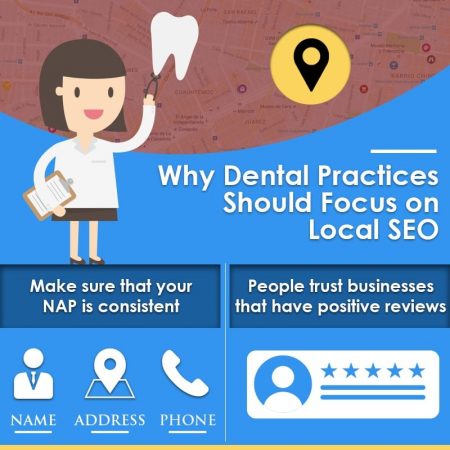 When you read about search engine optimization (SEO) you’ll find a lot of information for blogs and national retailers. Although much of this information is still pertinent when you’re working with dental SEO, there are two important differences. You’re not selling anything online and you don’t need to target the entire internet. Instead, your goal is to acquire leads near where you’re located which is why you need local SEO.
When you read about search engine optimization (SEO) you’ll find a lot of information for blogs and national retailers. Although much of this information is still pertinent when you’re working with dental SEO, there are two important differences. You’re not selling anything online and you don’t need to target the entire internet. Instead, your goal is to acquire leads near where you’re located which is why you need local SEO.
Local vs. Organic SEO
To understand how different search queries are treated by Google all you have to do is run a search for something like “signs of tooth decay.” What you’ll come up with are results from informational websites, blogs, and magazines that are targeted to either a national or an international audience. You probably won’t even find a dentist in the top results because this is organic SEO.
However, when you search for “tooth decay treatment near me” Google understands that this search is with local intent. This is why you’ll find places such as dental offices that are located near you. To optimize your website to show up here you’ll need local dentist SEO.
Why Dental SEO is Different
Organic SEO is about optimizing your website. To do this you must have content on your website. With dental SEO you’re not optimizing a URL, you’re optimizing a business – something that’s identified by its NAP (name, address, and phone number). Citing (mentioning) your dental practice is important here even if you don’t have a URL.
Usually, Google will find information by “crawling” your website. When you don’t have links it’ll use data aggregators instead. These pull information from sources like phone directories and business listings. This is why you need a lot of places accurately mentioning your practice to do well with dental SEO.
Best Practices for Dentist SEO
Dental SEO is different from general SEO in many important ways, including:
- Google My Business is the most important platform for your local business’ listing. You’ll want to claim your profile, fill in the details, and remove any duplicate listings.
- When it comes to on-site optimization all the typical factors are important but you must also make sure to optimize your location information. This is why you need a contact page, a phone number that people can click on, and your NAP details in your site’s footer.
- An important part of dentist SEO is making sure that your NAP is consistent. Even a small inconsistency or variation can count against you. This is why it’s so important to update your practice’s details everywhere anytime they change.
- Google finds your citations in a variety of locations. This is why you should always do your best to get your practice out there (with an accurate NAP). Keep everything up-to-date and use third-party local aggregators (LDA) to help you acquire and maintain citations.
- People trust businesses that have positive reviews. These also play a role in dental SEO.
- You’ll want to include pages on your website that target nearby cities and their zip codes. In doing so, make sure you remain mindful of Google’s quality standards or you won’t help your dentist SEO any.
What Organic and Dentist SEO Share in Common
You want to also spend some time focusing on organic SEO. There are still some principles of site optimization that apply, including:
- Efficient site navigation
- Optimized content and meta tags
- Diverse backlinks
- A great user experience
- No technical errors
When you need help with dentist SEO in Tampa, FL, make sure you reach out to the Local SEO Tampa Company. Put their years of experience to work for you today.
